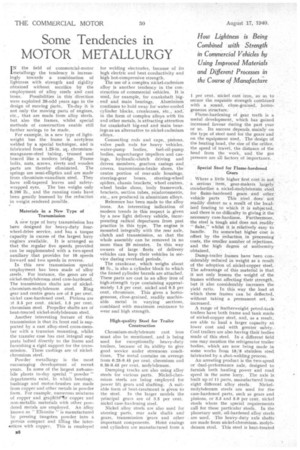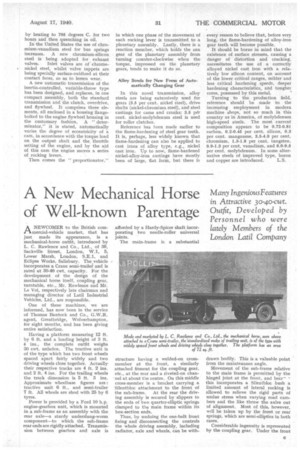Some Tendencies in MOTOR METALLURGY
Page 26

Page 27

If you've noticed an error in this article please click here to report it so we can fix it.
How Lightness is Being Comb fried with Strength in Commercial Vehicles by Using Improved Materials and Different Processes in the. Course of Manufacture I N the field of commercial-motor metallurgy the tendency is increasingly towards a combination of lightness with strength and rigidity obtained without sacrifice by the employment of alloy steels and cast
irons. Possibilities in this direction were exploited 20-odd years ago in the design of moving parts. To-day it is not only the moving parts of engines, etc., that are made from alloy steels. but also the frames, whilst special methods of construction enable still further savings to be made.
For example, in a new type of lightweight bus the frame is acetylene welded by a special technique, and is fabricated from 1,25-in. sq. chromiummanganese-steel tubing, trussed and braced like a modern bridge. Frame bolts, nuts, screws, rivets and wooden parts are thereby eliminated. The springs are serni-elliptics and' are made from chromium-vanadium steel. They have roll-tapered leaves and safetywrapped eyes. The bus weighs only 8,100 lb., and the running costs have been greatly lessened by the reduction in weight rendered possible.
Materials in a New Type of Transmission
A new type of lorry transmission has been designed for heavy-duty fourwheel-drive service, and has a torque capacity in excess of the, largest lorry engines available, It is arranged so that the regular five speeds provided can be supplemented with a two-speed auxiliary that provides for 10. speeds forward and two speeds in reverse.
In this new transmission special employment has been made of alloy steels. For instance, the gears are of nickel-molybdenum steel case-hardened. The transmission shafts are of nickelchromium-molybdenum steel. Ring gear and centre gears are of 5 per cent. nickel case-hardened steel. Pinions are af 9.5 per cent. .nickel. 1.5 per cent. chromium steel. Propeller shafts are of heat-treated nickel-molybdenum steel.
Another interesting feature of this transmission is that its front end is supported by a cast alloy-steel cross-member with a trunnion mounting, whilst the transfer case has cast integral supports bolted directly to the frame and furnishing a rigid support for the transmission. These castings are of nickelchromium steel.
Powder metallurgy is the most encouraging development of recent years. In some of the largest automobile plants to-day special " powder " departments exist, in which bearings, bushings and motor-brushes are made from copper and other metals in powder form. For example, numerous mixtures of copper and graphite-!r copper and non-metallic materials with other powdered metals are employed. An alloy known as " Elkonite " is manufactured by pressing tungsten powder into a porous compact and filling the inter
• stices with copper. This is employed for welding electrodes, because of its high electric and heat conductivity and high hot-compressive strength.
The use of a complex nickel-cadmium alloy is another tendency in the construction of commercial vehicles, It is used, for example, for crankshaft bigend and main hearings. Aluminium continues to hold sway for water-cooled cylinder blocks, crankcases, etc., and, in the form of complex alloys with tin and other metals, is attracting attention for crankshaft big-end and main bearings as an alternative to nickel-cadmium alloys.
Connecting rods and caps, pistons, valve push rods for heavy vehicles, water-pump bodies, fuel-oil-pump bodies, supercharger impellers and casings, hydraulic-clutch driving and driven members, gearbox casings and covers, transmission-brake shoes, the centre portion of rear-axle housings, steering-gear boxes, steering-wheel spiders, chassis brackets, wheel centres, wheel brake shoes, body framework, brackets, section tubes, reinforcements, etc., are produced in aluminium alloys.
Reference has been made to the alloy irons, An interesting indication of modern trends in this respect is given by a new light delivery vehicle, incorporating radical departures from past practice in this type. The engine is mounted integrally with the rear axle, clutch and transmission, so that the whole assembly can be removed in no more than 20 minutes. In this way owners of large fleets of delivery vehicles can keep their vehicles in service during overhaul periods.
The crankcase, which weighs about 85 lb., is also a cylinder block to which the finned cylinder barrels are attached. These parts are cast in an alloy iron of high-strength type containing approximately 1.5 per cent. nickel and 0.6 per cent. chromium. This gives a homogeneous, close-grained, readily machinable metal in varying sections, combined with maximum resistance to wear and high strength.
High-quality Steel for Trailer Construction
Chromium-molybdenum cast iron must also be mentioned, and is being used for exceptionally heavy-duty trailers, because of its ability to give good service under strenuous conditions. The metal contains on average from 0.25-0.45 per cent, chromium and 0.35-0.45 per cent. molybdenum.
Dumping trucks are also using alloy steels for various parts. Nickel-chrominus steels are being employed for power lift gears and shafting. A suitable form of heat-treatment is given to the steel. In the larger models the principal gears are of 3.5 per cent. nickel case-hardening steel.
Nickel alloy steels are also used for steering parts, rear axle shafts and gears, transmission 'gears and other important components. Hoist casings and cylinders are manufactured from a 1 per cent, nickel cast iron, so as to secure the requisite strength combined' with a sound, close-grained, homogeneous structure.
Flame-hardening of gear teeth is a useful development, which has gained increased favour during the past year or so. Its success .depends, mainly on the type of steelused for the gears'and on the equipment used. • The design of the heating head, the size of the orifice, the speed of travel, the diStance.of the head from the work, . and the gas pressure are all factors of importance.
Special Steel for Flame-hardened Gears
Where a little higher first cost is not a serious item, gear-inakers largely standardize a nickel-ntolyhdenurn steel for flame-hardened gears and other vehicle parts This steel does not readily distort as a result of the localized heating to which it is subjected, and there is no difficulty in giving it the necessary, case-hardness. Furthermore,
• the steel is tough and does not readily " flake," whilst it is relatively easy to handle. Its somewhat higher cost is offset by the reduction in processing costs, the smaller number of rejections, and the high degree of uniformity obtained.
Dump-trailer frames have been considerably reduced in weight as a result of the adoption of nickel-copper steel. The advantage of this material is that it not only lessens the weight of the frames without affecting their strength, but it also considerably increases the yield ratio. In this way the load at which these frames can be deflected, without taking a permanent set, is increased.
A range of featherweight petrol-tank trailers have both frame and tank made of nickel-copper steel, and, as a result, are able to haul a larger capacity at lower cost and with greater safety. Coal trailers are also having their bodies made of this steel. In a different field one may mention the refrigerator trailer bodies, which are now 'being made in some works from 18/S stainless steel fabricated by a shot-welding process.
An arresting product is the two-speed or dual-performance axle, designed to furnish both hauling power and road speed in the same lorry. The axle is built up of 11 parts, manufactured from
eight different alloy steels. Nickelmolybdenum steels are used for the case-hardened parts, such as gears and pinions, or 5.5 and 5.0 per cent, nickel steels where the special requirements call for these particular steels. In the planetary unit, oil-hardened alloy steels are used. The heavy-duty axle shafts are made from nickel-chromiummolybdenum steel. This steel is heat-treated
by heating to 795 degrees C. for two hours and then quenching in oil.
In the United States the use of chromium-vanadium steel for bus springs increases. A new chromium-silicon steel is being adopted for exhaust
valves. Inlet valves are of chrome, nickel steel, whilst valve tappets are being specially surface-oxidised at their contact faces, so as to lessen wear.
A new automatic transmission of the inertia-controlled, variable-throw type has been designed, and replaces, in one compact assembly, both the standard transmission and the clutch, overdrive, and flywheel. It comprises three elements, all enclosed in a housing flangebolted to the engine flywheel housing in the customary fashion. A " determinator," it is stated, automatically varies the degree of eccentricity of a cam, in accordance with the torque load on the output shaft and the throttle setting of the engine, and by the aid of this cam the engine moves a series of rocking levers.
Then comes the " proportionator." in which one phase of the movement of cacti rocking lever is transmitted to a planetary assembly. Lastly, there is a reaction member, which holds the sun gear of the planetary assembly from turning counter-clockwise when the torque, impressed on the planetary gears, tends to make it do so.
Alloy Steels for New Form of Automatically Clanging Gear In this novel transmission, alloy steels are being extensively used for gears (3.5 per cent, nickel steel), drive shafts (nickel-chromium steel), and steel castings for cams and cranks; 3.5 per cent, nickel-molybdenum steel is used for roller clutches.
Reference has been made earlier to the flame-hardening of steel gear teeth. It is, perhaps, less widely known that flame-hardening can also be applied to cast irons of alloy type, e.g., nickel cast iron. Up to now, flame-hardened nickel-alloy-iron castings have mostly been of large, flat form, but there is every reason to believe that, before very long, the flame-hardening of alloy-iron gear teeth will become possible.
It should be borne in mind that the existence of surface stresses, causing a danger of distortion and cracking, necessitates the use of a correctly alloyed nickel cast iron with a relatively low silicon content, on account of the lower critical ranges, milder and less critical hardening speeds, deeper hardening characteristics, and tougher cores, possessed by this metal.
Turning to the production field, reference should be made to the increasing employment in modern machine shops, not so much in this country as in America, of molybdenum high-speed steels. The most current composition appears to be 0.72-0.81 carbon, 0.2-0.45 per cent. silicon, 0.3 per cent. manganese, 3.5-4.0 per cent. chromium, 1.3-1.8 per cent. tungsten, 0.9-1.3 per cent, vanadium, and 8.0-9.5 per cent. molybdenum. In some alternative steels of improved type, boron and copper are introduced, L.S.




























































